Heating system of an apartment building: technical device
The simplest climate network of a private house consists of a heating boiler, radiators and pipes connecting these elements into a closed ring through which coolant circulates. However, the heating systems of high-rise buildings are arranged in a completely different way, which must be taken into account when repairing or modernizing its component located in an apartment. Otherwise, problems with neighbors and housing offices will not be avoided.
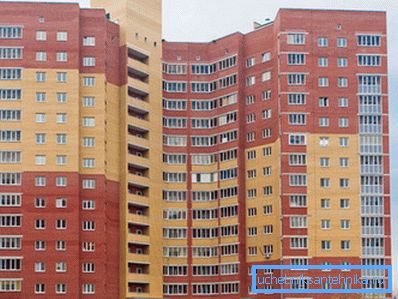
The scheme of arrangement of heating with a central flow of coolant
House distribution node
The heating system in an apartment building begins with a stop valve, which is installed on the pipe connecting the pipelines in the basement with the flow and discharge heat lines (instructions attached to SNiP 41-01-2003).
Note! This moment is very important for workers of housing and communal services and the organization delivering heat. It is through this valve that their powers are divided: the organization providing heating services is responsible for the safety and operability of external communications, the housing department or the condominium should be concerned about internal health.
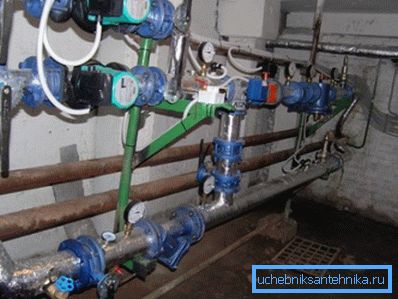
After the stopcock, there is a variety of equipment needed to circulate coolant and hot water through apartments located on all floors of the house. Its list and description are given in the table.
| Detail of the distribution node | Description |
| Hot water inlets | Immediately after the valve that blocks the flow of coolant, the nozzles are mounted for connection to hot water pipes. There may be one or two tie-ins (respectively for a single-pipe or two-pipe scheme). In the latter case, the nozzles are interconnected by a jumper, due to which constant pressure and circulation of water in hot water pipes and heated towel rails mounted in the bathrooms are provided. |
| Elevator heating | This is the main element of the climate network, without which the heating system of a multi-storey building with centralized coolant supply cannot exist. It consists of a nozzle and socket, which create increased pressure. Thanks to him, the liquid reaches the upper wiring of the heating pipes (in the attic). In addition, there may be a leak, which involves in the repeated cycle the coolant coming from the return line. |
| Gate valves | They are used to cut off the heating circuit of apartments from the common piping system. In winter, for obvious reasons, they are in the open state, in the summer they are blocked. |
| Drain fittings | It is installed in the lower parts of the pipeline and serves to discharge coolant in the summer period or, if necessary, to repair elements of the heating network located in the house. |
| Connecting pipe with stop valves | In the lower part of the heating system, a pipe is installed connecting the heating system to the cold water supply pipes. It is necessary to fill the heating radiators in the summer to prevent the formation of corrosion lesions in batteries. |
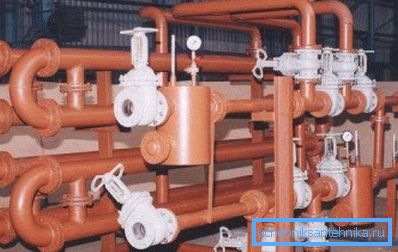
The heating system of an apartment building is adjusted by changing the diameter of the heating elevator nozzle. By closing and opening the corresponding valve, the housing and utilities worker speeds up or slows down the circulation of the coolant in the heating system, thereby changing the temperature in the radiators.
Supply and discharge pipelines
The next important element of the heating system of apartment buildings is the risers that supply water to each floor of the house and discharge the cooled coolant that flows through the batteries installed in the dwellings.
There are two main schemes:
- Heat carrier is fed through one pipe, and is removed through another. These main risers, located at different ends of the house, on each floor are interconnected by jumpers through which the fluid flows, getting along the way in all the batteries. This is how the heating system of a 5-storey multi-storey old house is organized.

Such a scheme was subsequently abandoned, since it makes it difficult to completely discharge the coolant. When airing pipes or radiators in a certain apartment, it is very difficult to remove all the water from the horizontal sections of the pipelines.
- Water flows through a vertical pipe into the attic, and then goes down, flowing from the battery to the battery, from the top floor to the bottom..
Note! Both of these water distribution schemes have one major drawback - the jumper located in the attic or the technical floor. It is necessary for the discharge of air through the air valve, but leads to quite significant heat loss, which reduces the efficiency of the climate system as a whole.

Given that the technical levels of apartment buildings (attics and basements) are not heated, there is a danger of the freezing of the coolant in case of an accident of the heating system.
To avoid this, the following design features of heating risers are provided:
- The slope of the horizontal jumpers. If the drop in height of pipelines provided for by SNiP is properly observed, during the descent of the coolant all the liquid from their pipes goes away and the formation of ice capable of breaking pipes and radiators is completely excluded.
- Heating technical floors. Although heating radiators in the attic and in the basement are not provided, the pipes themselves, despite the glass wool or mineral fiber covering them, still heat the air, so the coolant does not immediately cool down after an emergency heating stop.
- Great inertia. The upper and lower lintels of the risers are quite large in diameter pipes (more than 50 mm). Their cooling after the cessation of heat does not occur immediately. Due to this, the water in them does not have time to freeze.

In general, the currently used scheme with the upper distribution of the coolant is quite effective, although it has some features of operation:
- Starting the heating system is as simple as possible. It is enough to open the shut-off armature blocking the access of water and the air valve in the attic. After filling the pipes with water, the latter is blocked in order to avoid loss of coolant. At this event, the launch of the climate network ends.
- On the contrary, turning off the heating and emergency discharge of the coolant is difficult. You must first find the desired pipe on the top floor, close the valves there, and then open the valve on the lower section of the riser.
- With vertical distribution, the distribution of heat is uneven (although the price of heating services is the same). The fact is that the upper apartments get a hotter heat carrier, which warms up the apartment better. To compensate for this, in the apartments located below you need to install heating radiators with a large number of sections.
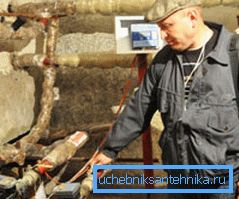
Heat exchangers in the apartments
If you did not replace the heating devices in a city apartment with your own hands, then it is heated by one of two devices:
- Cast iron battery. It has a small heat transfer, significant inertia, huge weight and not at all aesthetic appearance. On the other hand, this device can be used with a heat carrier of any quality. Cast iron is practically not susceptible to corrosion and can last more than 50 years with periodic cleaning of internal deposits.
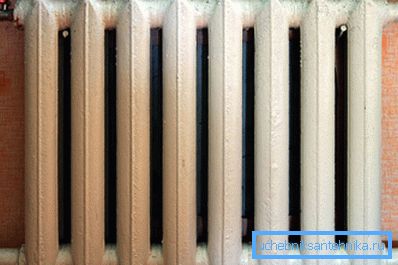
- Steel tube with heat exchanger plates. This heating device was installed in connection with the savings in the construction of houses and does not hold water.
Now the best option for a heating system with a central coolant supply is rightly considered to be bimetallic heating radiators.
These devices consist of:
- steel frame through which coolant flows;
- aluminum heat exchanger, worn on the frame - it increases heat transfer and gives the battery an attractive appearance.
Durable steel pipes inside prevent corrosion (unlike all-aluminum radiators) and give strength to the radiator, protecting against hydraulic and pneumatic shocks, which are not uncommon for centralized heating systems.
Another positive point in using a bimetallic device is high power. This makes it possible to use fewer sections.
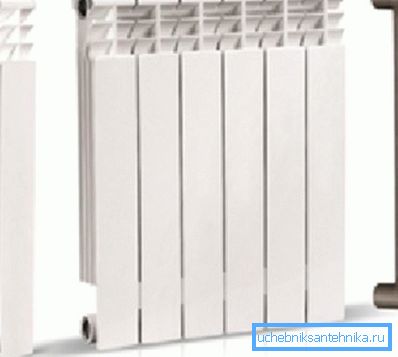
The only downside is the high cost. The described heating units are among the most expensive among all the currently existing heating equipment.
Note! If there are regulating valves on the inlet pipes of your batteries — taps, thermostats, chokes, and so on — you must equip the bypass (the jumper between the inlet and outlet of the battery). Otherwise, the thermostat will control the volume of coolant not only in your battery, but in all the apartments located below, which is unlikely to please the neighbors.
Features of hot water systems
The organization engaged in heating apartment buildings, knows and supplies hot water to consumers.
Like the climate system, this engineering network has some distinctive features:
- Heating of hot water and coolant during the heating period is centralized. Most often, the same piping is used to supply both liquids. To separate the flow, valves are used, located in the basement.
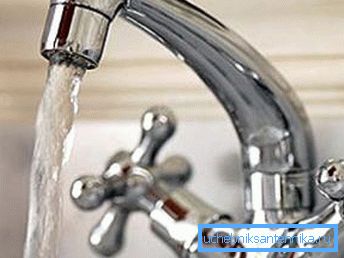
- The hot water system can have one or two pipes. The latter scheme is more preferable, since it allows you to avoid the excessive consumption of water that occurs in a single-pipe system when the valve is opened (each consumer waits until the cooled water is drained and the hot water begins to flow).
- Often radiators installed in the bathroom and used for drying towels are connected to the hot water pipeline. This is not a very good scheme, as the heated towel rail remains hot in the summer, making it uncomfortable to stay in the bathroom.
Tip! To solve this problem is simple. During repairs or when replacing heating equipment in an apartment, shut-off valves should be put on the inlet and outlet fittings. Do not forget to equip the bypass.
- Due to the fact that hot water is supplied through the pipes of heating, it is often turned off in the summer. It is necessary to carry out maintenance work on the main equipment of heating networks.
Conclusion
The heating system of apartment buildings with centralized coolant flow is fundamentally different from individual climate networks. Unqualified intervention and modernization can not only worsen the quality of heating at the neighbors, but also lead to complete obstruction of the pipelines.
Therefore, when performing any work, it is necessary to strictly observe the prescribed rules or use the services of qualified specialists. You can learn more about the engineering networks of high-rise buildings from the video posted in this article.